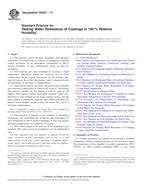Potrebujeme váš súhlas na využitie jednotlivých dát, aby sa vám okrem iného mohli ukazovať informácie týkajúce sa vašich záujmov. Súhlas udelíte kliknutím na tlačidlo „OK“.
ASTM D2247-11
Standard Practice for Testing Water Resistance of Coatings in 100% Relative Humidity
Automaticky preložený názov:
Štandardný postup skúšania odolnosť proti vode povlakov v 100% relatívnej vlhkosti
NORMA vydaná dňa 1.2.2011
Informácie o norme:
Označenie normy: ASTM D2247-11
Poznámka: NEPLATNÁ
Dátum vydania normy: 1.2.2011
Kód tovaru: NS-19760
Počet strán: 7
Približná hmotnosť: 21 g (0.05 libier)
Krajina: Americká technická norma
Kategória: Technické normy ASTM
Anotácia textu normy ASTM D2247-11 :
Keywords:
adhesion, blistering, humidity, resistance-water, rust, Blistering, Adhesion--paints/related coatings/materials, Coatings (paint/related applications), Exposure tests--organic coatings, Exterior coatings, Industrial coatings/applications, Interior paints/coatings, Latex paints, Relative humidity (RH), Rust, Solventborne paints/coatings, Varnishes, Water resistance, ICS Number Code 87.040 (Paints and varnishes)
Doplňujúce informácie
| Significance and Use | ||||||||||||||||||||||||||||
|
Water can cause the degradation of coatings, so knowledge of how a coating resists water is helpful for assessing how it will perform in actual service. Failure in tests at 100 % relative humidity may be caused by a number of factors including a deficiency in the coating itself, contamination of the substrate, or inadequate surface preparation. This practice is therefore useful for evaluating coatings alone or complete coating systems. Tests at 100 % relative humidity are used for specification acceptance, quality control, and research and development for coatings and substrate treatments. Some tests are used for a pass or fail determination at an arbitrary time. A coating system is considered to pass if there is no evidence of water-related failure after a period of time. Other tests are used to monitor degree of failure as a function of exposure time. Arbitrary pass/fail levels and the test durations required are typically set in other material specific test methods. Users of this practice alone may use the known performance of the controls to set test end points. Another option is to continue the test until all specimens have failed, and use the time to reach failure as a way to differentiate performance. Results obtained from the use of 100 % humidity tests in accordance with this practice should not be represented as being equivalent to a period of exposure to water in the natural environment, until the degree of quantitative correlation has been established for the coating or coating system. The test chamber can be a small laboratory cabinet or a room large enough to hold an automobile or a truck. Some automobile manufacturers test completed vehicles in rooms maintained at 100 % relative humidity. Corrosion tests can be conducted, as the condensate dripping off the test articles in not recirculated. |
||||||||||||||||||||||||||||
| 1. Scope | ||||||||||||||||||||||||||||
|
1.1 This practice covers the basic principles and operating procedures for testing water resistance of coatings by exposing coated specimens in an atmosphere maintained at 100 % relative humidity so that condensation forms on the test specimens. 1.2 This practice uses the technique of creating a slight temperature differential within the exposure area to form condensation on the coated specimens. As the warmer saturated air passes the cooler specimens, water is deposited onto the specimens in the form of condensation. 1.3 This practice places the entire specimen in the exposure area allowing condensation to form on all surfaces. This makes this practice suitable for flat panels as well as large or 3D objects. This practice differs from other methods where condensation is only formed on the front coating surface, but the back surface is outside the exposure area. Other tests may also deposit water droplets on the surface but where the source is not from condensation. Note 1—Alternative practices for testing the water resistance of coatings include Practices D870, D1735, and D4585. 1.4 This practice is limited to the methods of obtaining, measuring, and controlling the conditions and procedures of tests conducted in 100 % relative humidity. It does not specify specimen preparation, or evaluation of results. 1.5 The values stated in SI units are to be regarded as the standard. The values given in parentheses are for information only. 1.6 This standard does not purport to address all of the safety concerns, if any, associated with its use. It is the responsibility of the user of this standard to establish appropriate safety and health practices and determine the applicability of regulatory limitations prior to use. |
||||||||||||||||||||||||||||
| 2. Referenced Documents | ||||||||||||||||||||||||||||
|
Odporúčame:
Aktualizácia technických noriem
Chcete mať istotu, že používate len platné technické normy?
Ponúkame Vám riešenie, ktoré Vám zaistí mesačný prehľad o aktuálnosti noriem, ktoré používate.
Chcete vedieť viac informácií ? Pozrite sa na túto stránku.




 Cookies
Cookies
